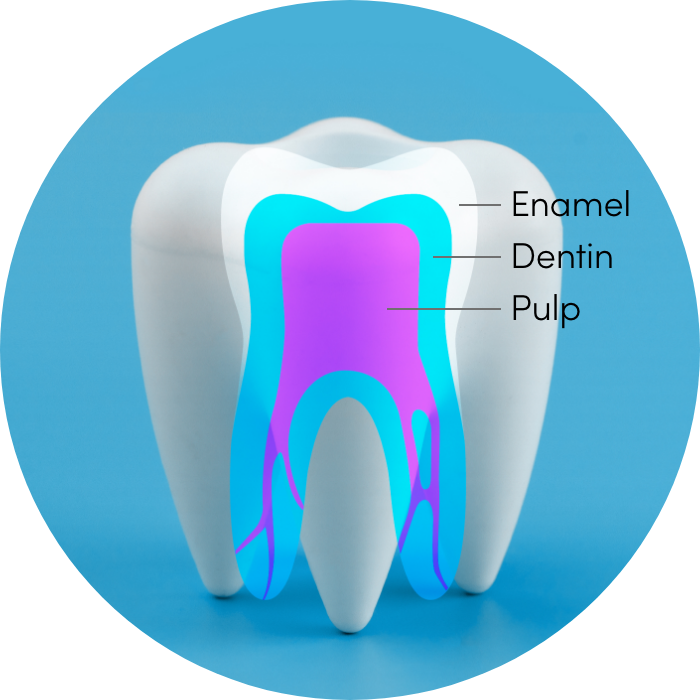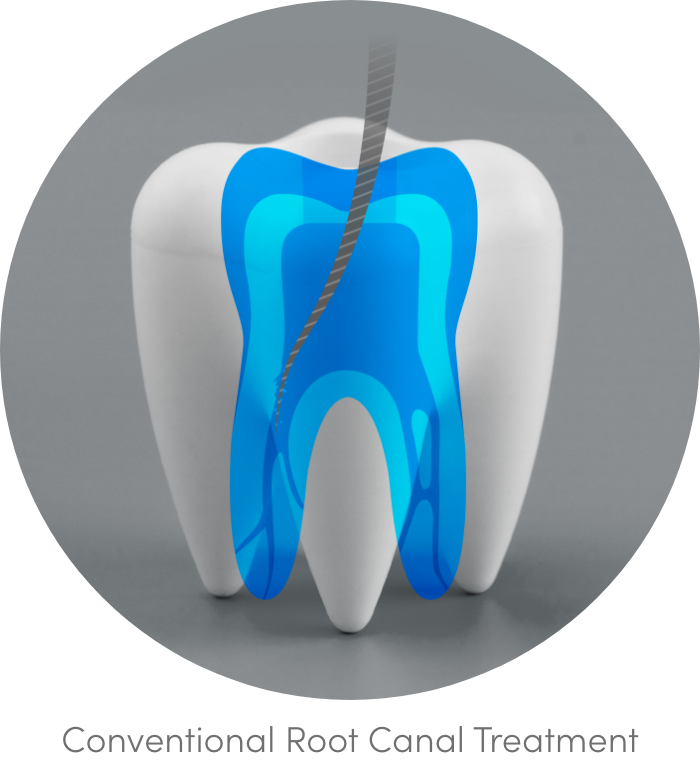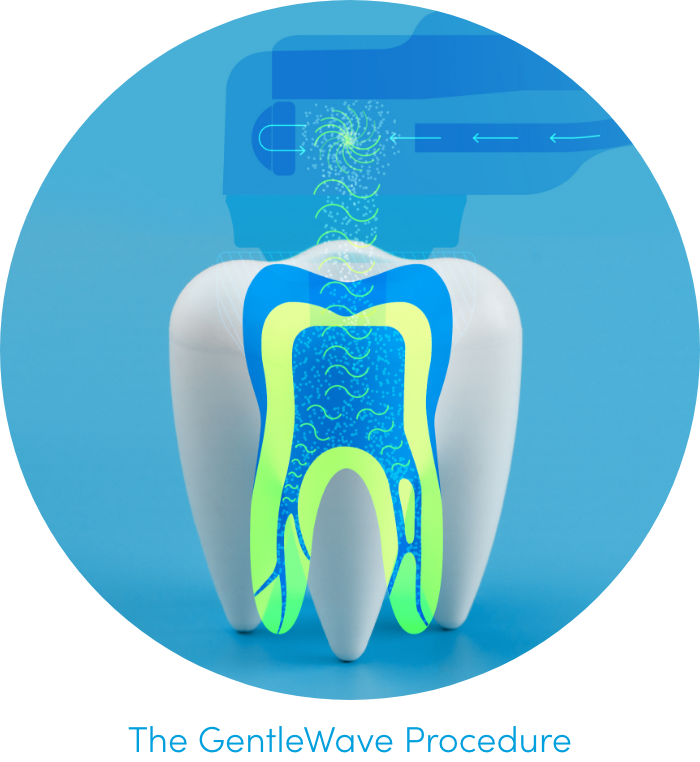Did you know that you can have a root canal system infection without experiencing any signs or symptoms? Seeing your dentist for regular checkups is essential in maintaining your oral health as it can reveal a root canal infection before it becomes critical. Knowing what causes a root canal infection can help you determine when you might be at risk.
 What Is a Root Canal Infection?
What Is a Root Canal Infection?
On the inside of teeth, under the white outer layer of enamel and inner layer of dentin, is a soft tissue called the pulp*. Tooth pulp consists of blood vessels, nerves and connective tissue that can become inflamed or infected; this is an infected root canal*.
What Causes a Root Canal Infection?
An infected root canal occurs when bacteria that live in the mouth invade the tooth pulp**, which can result from:
- A crack or chip in the tooth
- A fractured tooth root
- Damage to the tooth pulp (with or without damage to the exterior of the tooth)
- Repeated dental procedures
- Tooth decay*
All of these causes of root canal infection can occur without symptoms, stressing the importance of seeking treatment as soon as an issue starts or is suspected.
What Are the Risks of Leaving a Root Canal Infection Untreated?
Unfortunately, root canal infections don’t just go away on their own. In fact, the longer you wait to seek treatment, the worse the situation can become***. Tooth decay can continue to spread and destroy otherwise healthy tooth structure until there isn’t sufficient structure left to save the tooth. Under these circumstances, the only option is to extract the tooth, which then requires a dental bridge or costly implant. You can opt to not replace the tooth, though this can result in additional issues such as shifting of the remaining teeth, bite irregularities and bone loss†.

“If left unaddressed, some oral health issues can lead to life-threatening conditions that can only be addressed within a hospital setting.” – Dr. Mark Limosani, GentleWave® Doctor
Letting a root canal system infection persist can result in severe consequences. The infection can spread into the gums, cheeks and other teeth—but also, into the jaw, the face and into the bloodstream***. Once the infection reaches the bloodstream, the patient is at risk for several life-threatening complications, including the following as outlined by Healthline:
- Sepsis
- Brain abscess
- Bone tissue infection
- Necrotizing fasciitis
- Endocarditis
- Mediastinitis††
Get the answers you need from your doctor with 5 Questions to Ask Your Endodontist About Your Root Canal Treatment.
What Are the Signs and Symptoms of a Root Canal Infection?
 Paying attention to your oral health and knowing the indicators of infection can help catch problems before they progress. The Cleveland Clinic notes the following signs and symptoms to be aware of that might indicate you need a root canal:
Paying attention to your oral health and knowing the indicators of infection can help catch problems before they progress. The Cleveland Clinic notes the following signs and symptoms to be aware of that might indicate you need a root canal:
- Persistent tooth pain
- Sensitivity to heat and cold
- Swollen gums or jaw
- Pimple on the gums
- Tooth discoloration
- Chipped, cracked or loose tooth
- Pain from applied pressure**
What Happens During a Conventional Root Canal Treatment?
 To resolve the infection inside the tooth, the dentist or endodontist removes the tooth pulp. Before the treatment starts, x-rays are taken, and the patient is prepared with local anesthesia and dental dam placement. Treatment begins by creating an opening in the crown of the tooth to gain access to the pulp*. During a conventional root canal treatment, small files are used to remove infected tissue and decayed tooth structure, as well as shape the inside of the canal to accommodate the material used to fill the tooth*. Once canal shaping is complete, the tooth roots are completely sealed off and a temporary filling is placed until the patient returns for a follow-up appointment for crown placement*.
To resolve the infection inside the tooth, the dentist or endodontist removes the tooth pulp. Before the treatment starts, x-rays are taken, and the patient is prepared with local anesthesia and dental dam placement. Treatment begins by creating an opening in the crown of the tooth to gain access to the pulp*. During a conventional root canal treatment, small files are used to remove infected tissue and decayed tooth structure, as well as shape the inside of the canal to accommodate the material used to fill the tooth*. Once canal shaping is complete, the tooth roots are completely sealed off and a temporary filling is placed until the patient returns for a follow-up appointment for crown placement*.
Get prepared for treatment with our guide on Planning for Your Root Canal Therapy and remember that you have choices in treatment.
What is an Alternative to Conventional Root Canal Treatment?
 The GentleWave® Procedure is a modern alternative to conventional root canal treatment that offers several unique patient advantages. The GentleWave Procedure follows the principal protocols of conventional treatment but minimizes file use in order to preserve more tooth structure4. Preserving tooth structure helps keep the remaining tooth strong, as well as reduces postoperative pain4and promotes fast healing4 for the patient. Additionally, the GentleWave Procedure typically is completed in one appointment4, providing less disruption to a patient’s schedule.
The GentleWave® Procedure is a modern alternative to conventional root canal treatment that offers several unique patient advantages. The GentleWave Procedure follows the principal protocols of conventional treatment but minimizes file use in order to preserve more tooth structure4. Preserving tooth structure helps keep the remaining tooth strong, as well as reduces postoperative pain4and promotes fast healing4 for the patient. Additionally, the GentleWave Procedure typically is completed in one appointment4, providing less disruption to a patient’s schedule.
Over one million patients have been treated with the GentleWave® Procedure. Hear from real patients about their treatment experiences.
Locate a GentleWave® Doctor
 If you’re interested in talking to an endodontist about the GentleWave Procedure, use the GentleWave Doctor Locator to find a doctor near you.
If you’re interested in talking to an endodontist about the GentleWave Procedure, use the GentleWave Doctor Locator to find a doctor near you.
* AAE
*** Healthline
†† Healthline